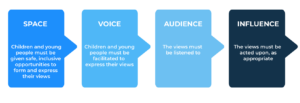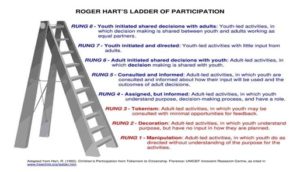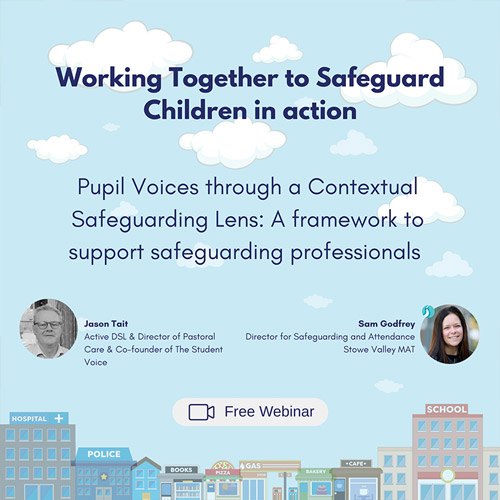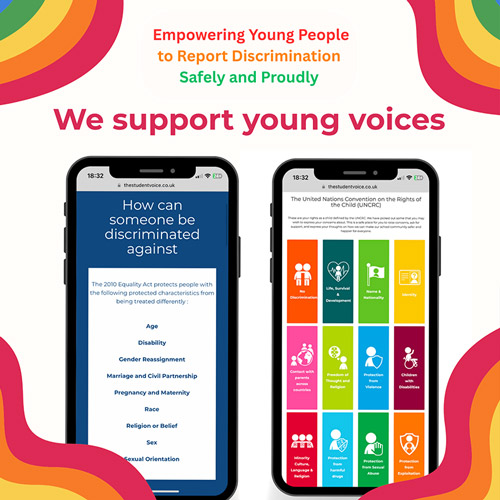Authentic Student Voice and The Journey to Shared Decision Making
A journey to authentic student voice
At the start of this school year, we wrote about The Student Voice and the implementation of The Lundy Model of Participation. Following feedback, observations, and some great conversations with some really talented and passionate people, we are following up with a blog that focuses on the influence part of Lundy’s Model of Participation.

Get our blogs sent straight to your inbox.
“The future belongs to young people with an education and the imagination to create” – President Barack Obama.
This statement rings true as both young people and adults come to terms with the world we live in at present.
The extent of how lockdown has impacted our lives and the reality of climate change, alongside movements such as #MeToo and #BlackLivesMatter, can lead to feelings of stress and uncertainty.
Adults and students will potentially have very different outlooks on these subjects. The result of this is a less than secure and known future for our young people and if we are to follow President Obama’s advice, we need to authentically engage with our young people. Educators in particular will be able to authentically engage with young people in a manner in which young people will feel heard.
This principle is a central pillar of The Student Voice Tool. Not only must schools and colleges provide avenues for students to share information about their life experiences, but it is fundamental that young people not only receive feedback from their input but are also included in decision making about their own learning environment and community. Professor Lundy refers to this as Influence – the views of the young person must be acted upon appropriately.
Sociologist, Roger Hart whose previous works were ‘Children’s Participation: The Theory And Practice Of Involving Young Citizens In Community Development And Environmental Care’ for UNICEF in 1997, created the ladder of participation. Through this, educators can assess where they are with Lundy’s view of Influence and how their setting may need to progress.

Article 12 and The Lundy Model of Participation
The Lundy Model of Participation was developed by Laura Lundy, a professor of international children’s rights, and it was designed to provide a way of conceptualising a child’s right to participation – as laid down in the UN Convention on the Rights of the Child which states that every child has the right to express their views on matters that affect them, and for these views to be taken into consideration. The Lundy model’s four elements are space, voice, audience, influence.
The Lundy Model of Participation was prominently featured in the Irish Department of Children and Youth Affairs’ recent National Strategy on Children and Young People’s Participation in Decision Making (2015 – 2020).
Dr. James Reilly, TD. Minister for Children and Youth Affairs stated “The strategy focuses on the everyday lives of children and young people and the places and spaces in which they are entitled to have a voice in decisions that affect their lives, including in community, education, health, and well-being, and legal settings. The strategy is primarily aimed at children and young people under the age of 18, but also embraces the voice of young people in the transition to adulthood.”
This model is so very relevant to The Student Voice because we strive to work on all four elements. The technology-based approach gives students an easy-to-access space – a virtual space – to be able to share their views. It enables them to use their voice to the most relevant audience within the school and gives them genuine influence on the issues that affect them, including their right to be safe from harm in their place of education and community as a whole. This will work to meet the challenge set by Ofsted, who have stated that schools need to create a culture that removes barriers to reporting harm that students might be experiencing.
Adult engagement initiatives in the workplace
If we can draw parallels and learn from workplace studies, helping students engage in decision-making when they are at school or college can go on to assist them in later life. Studies show that 43% of highly engaged employees receive feedback at least once a week, and teams that are highly engaged perform 20% better. Encouraging shared decision making and feedback from an early age could lead to better collaboration, lower absenteeism, stronger empathy, and understanding, preparing our youth for future working environments.
Feedback and shared decision making
Schools, colleges, and students need to develop communication methods and shared decisions by providing a continuous cycle of engagement if they are to move up the ladder of participation. Educators have a responsibility to advise students on effective ways to be realistic about their expectations and to be clear that both adults and students may not always get the results they hope for.
Although children and young people can be powerful and effective advocates for their own rights, it should be adults that facilitate the process, as they are the group able to provide resources. It is also important that they take responsibility for providing effective and realistic feedback to students’ views and use the student’s voice as a fundamental aspect to remove barriers to reporting.
Lundy recommends a four ‘Fs’ feedback process for consultations or collective/shared decision-making processes with children and young people:
- Full: Provide comprehensive feedback to children and young people outlining which of their views were accepted, which were not accepted, and the reasons for these decisions. This feedback should also note who is implementing their views and what is happening next.
- Friendly: Feedback or responses given by decision-makers to children or young people need to be in a format and language that they understand. They need to be informed about the findings of a consultation or survey and about how their views were given due weight.
- Fast: Children and young people quickly grow up and move on from things they are involved with, so decision-makers need to give them feedback acknowledging their contribution, outlining initial progress, and giving information on the next steps as soon as possible. This applies to all key stages and developments.
- Followed-up: Decision-makers need to provide ongoing feedback and information to children and young people throughout the policy or shared decision-making process.
If young people are to have an active role in building their own future, then they need to know how to use their voice to safeguard themselves, their communities, and those less able to stand up for themselves. Actively listening through providing safe and brave spaces for young people to share information only fulfils part of the conundrum. A continuous cycle of engagement aimed at shared decision-making with adults can only be achieved through appropriately acting on the voice of the young person in a timely, constant, and effective manner.
Failing to do so will prevent the active participation of students in their own learning environment and ultimately inhibit a school’s and/or college’s ability to prevent students from harm in the future, wherever in the institution or community it may come from.





